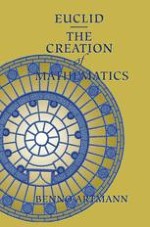This book is for all lovers ofmathematics. It is an attempt to under stand the nature of mathematics from the point of view of its most important early source. Even if the material covered by Euclid may be considered ele mentary for the most part, the way in which he presents it has set the standard for more than two thousand years. Knowing Euclid's Elements may be ofthe same importance for a mathematician today as knowing Greek architecture is for an architect. Clearly, no con temporary architect will construct a Doric temple, let alone organize a construction site in the way the ancients did. But for the training ofan architect's aesthetic judgment, a knowledge ofthe Greek her itage is indispensable. I agree with Peter Hilton when he says that genuine mathematics constitutesone ofthe finest expressions ofthe human spirit, and I may add that here as in so many other instances, we have learned that language ofexpression from the Greeks. While presenting geometry and arithmetic Euclid teaches us es sential features of mathematics in a much more general sense. He displays the axiomatic foundation of a mathematical theory and its conscious development towards the solution of a specific problem. We see how abstraction works and enforces the strictly deductive presentation ofa theory. We learn what creative definitions are and v VI ----=P:. . :re:. ::::fa=ce how a conceptual grasp leads to toe classification ofthe relevant ob jects.
